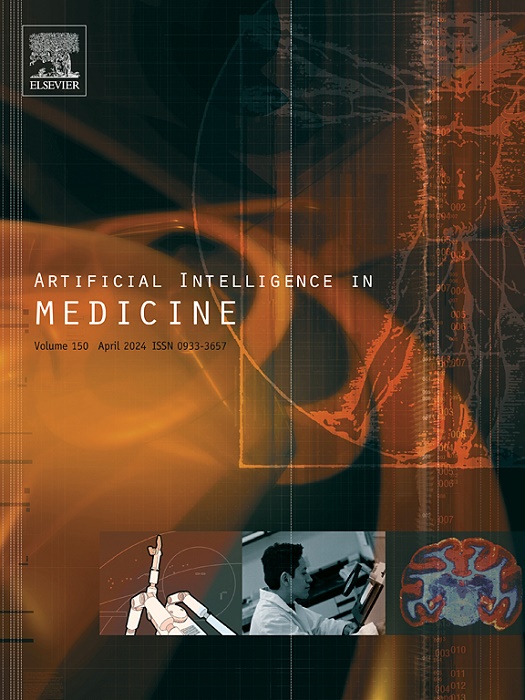Cascade learning in multi-task encoder–decoder networks for concurrent bone segmentation and glenohumeral joint clinical assessment in shoulder CT scans
IF 6.2
2区 医学
Q1 COMPUTER SCIENCE, ARTIFICIAL INTELLIGENCE
引用次数: 0
Abstract
Osteoarthritis is a degenerative condition that affects bones and cartilage, often leading to structural changes, including osteophyte formation, bone density loss, and the narrowing of joint spaces. Over time, this process may disrupt the glenohumeral (GH) joint functionality, requiring a targeted treatment. Various options are available to restore joint functions, ranging from conservative management to surgical interventions, depending on the severity of the condition. This work introduces an innovative deep learning framework to process shoulder CT scans. It features the semantic segmentation of the proximal humerus and scapula, the 3D reconstruction of bone surfaces, the identification of the GH joint region, and the staging of three common osteoarthritic-related conditions: osteophyte formation (OS), GH space reduction (JS), and humeroscapular alignment (HSA). Each condition was stratified into multiple severity stages, offering a comprehensive analysis of shoulder bone structure pathology. The pipeline comprised two cascaded CNN architectures: 3D CEL-UNet for segmentation and 3D Arthro-Net for threefold classification. A retrospective dataset of 571 CT scans featuring patients with various degrees of GH osteoarthritic-related pathologies was used to train, validate, and test the pipeline. Root mean squared error and Hausdorff distance median values for 3D reconstruction were 0.22 mm and 1.48 mm for the humerus and 0.24 mm and 1.48 mm for the scapula, outperforming state-of-the-art architectures and making it potentially suitable for a PSI-based shoulder arthroplasty preoperative plan context. The classification accuracy for OS, JS, and HSA consistently reached around 90% across all three categories. The computational time for the entire inference pipeline was less than 15 s, showcasing the framework’s efficiency and compatibility with orthopedic radiology practice. The achieved reconstruction and classification accuracy, combined with the rapid processing time, represent a promising advancement towards the medical translation of artificial intelligence tools. This progress aims to streamline the preoperative planning pipeline, delivering high-quality bone surfaces and supporting surgeons in selecting the most suitable surgical approach according to the unique patient joint conditions.
基于多任务编码器-解码器网络的级联学习在肩关节CT扫描中用于并发骨分割和肩关节临床评估
骨关节炎是一种影响骨骼和软骨的退行性疾病,通常会导致结构变化,包括骨赘形成、骨密度损失和关节间隙狭窄。随着时间的推移,这个过程可能会破坏肩关节(GH)的功能,需要有针对性的治疗。根据病情的严重程度,有多种方法可以恢复关节功能,从保守治疗到手术干预。这项工作引入了一个创新的深度学习框架来处理肩部CT扫描。它的特点是肱骨近端和肩胛骨的语义分割,骨表面的三维重建,GH关节区域的识别,以及三种常见骨关节炎相关疾病的分期:骨赘形成(OS), GH间隙缩小(JS)和肱骨肩胛骨对齐(HSA)。每种情况被分层成多个严重程度阶段,提供肩骨结构病理的综合分析。该管道由两个级联的CNN架构组成:用于分割的3D CEL-UNet和用于三重分类的3D关节- net。571个CT扫描的回顾性数据集,这些患者具有不同程度的GH骨关节炎相关病变,用于训练、验证和测试该管道。三维重建肱骨的均方根误差和Hausdorff距离中位数分别为0.22 mm和1.48 mm,肩胛骨的均方根误差和中位数分别为0.24 mm和1.48 mm,优于最先进的结构,使其潜在地适合基于psi的肩关节置形术术前计划背景。OS、JS和HSA的分类准确率在所有三个类别中始终保持在90%左右。整个推理管道的计算时间小于15 s,显示了该框架的效率和与骨科放射学实践的兼容性。所实现的重建和分类准确性,加上快速的处理时间,代表了人工智能工具在医学翻译方面的一个有希望的进步。这一进展旨在简化术前计划流程,提供高质量的骨表面,并支持外科医生根据患者独特的关节状况选择最合适的手术方法。
本文章由计算机程序翻译,如有差异,请以英文原文为准。
求助全文
约1分钟内获得全文
求助全文
来源期刊

Artificial Intelligence in Medicine
工程技术-工程:生物医学
CiteScore
15.00
自引率
2.70%
发文量
143
审稿时长
6.3 months
期刊介绍:
Artificial Intelligence in Medicine publishes original articles from a wide variety of interdisciplinary perspectives concerning the theory and practice of artificial intelligence (AI) in medicine, medically-oriented human biology, and health care.
Artificial intelligence in medicine may be characterized as the scientific discipline pertaining to research studies, projects, and applications that aim at supporting decision-based medical tasks through knowledge- and/or data-intensive computer-based solutions that ultimately support and improve the performance of a human care provider.
 求助内容:
求助内容: 应助结果提醒方式:
应助结果提醒方式:


